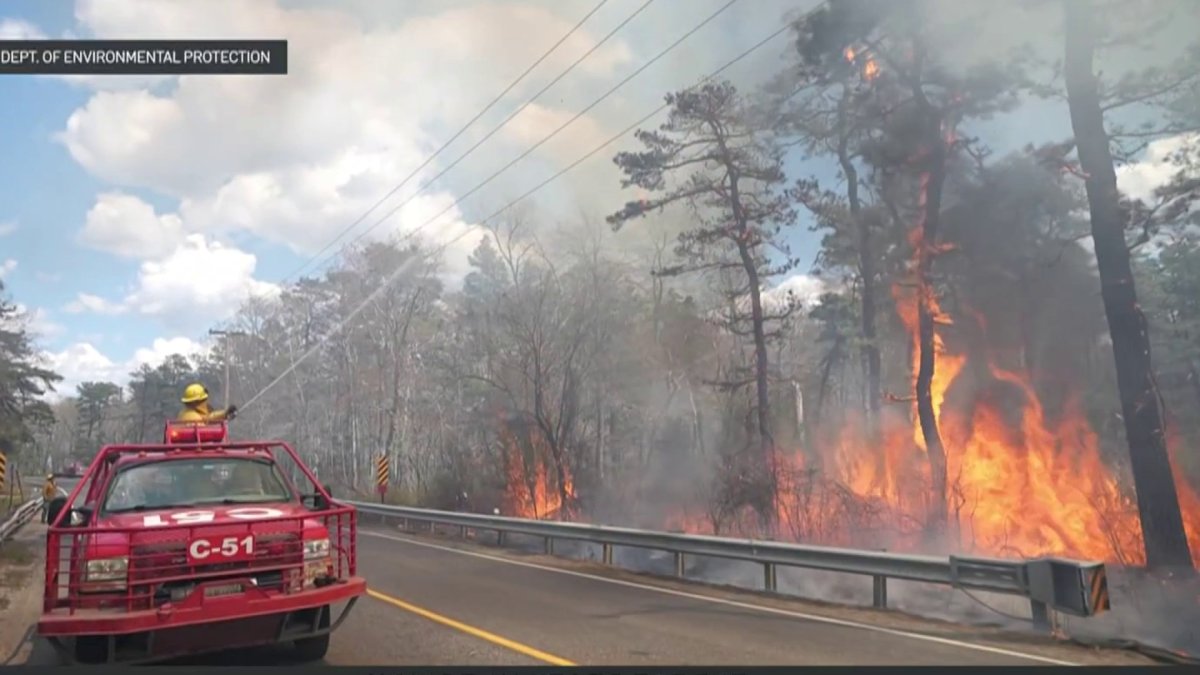
The New Jersey Forest Fire Service said firefighters continued to mop up a wildfire that spread to more than 500 acres of the Wharton State Forest before being contained Thursday morning.
What to Know
- Firefighters have completely contained a forest fire that burned several hundred acres in South Jersey.
- The blaze in the Wharton State Forest started sometime Tuesday night in Waterford Township in Camden County and spread into Shamong Township in neighboring Burlington County.
- The New Jersey Forest Fire Service says it burned 510 acres before it was declared fully contained as of 8 a.m. Thursday.
A wildfire burned more than 500 acres of a New Jersey state forest Wednesday into Thursday, sending thick white smoke into the air and closing a Camden County road for some time.
Around 8 a.m. Thursday morning, the New Jersey Forest Fire Service provided an update on social media saying that the fire had grown to cover 510 acres, but was 100% contained.
Get Philly local news, weather forecasts, sports and entertainment stories to your inbox. Sign up for NBC Philadelphia newsletters.
The fire was burning before 10 a.m. Wednesday in the Jackson Road area of Wharton State Forest in Waterford Township, Camden County, and Shamong Township, Burlington County, the New Jersey Forest Fire Service initially said on social media.
By 11 a.m. Wednesday, the fire covered at least 100 acres and was 0% contained the state forest fire service said.
Local
Breaking news and the stories that matter to your neighborhood.
Despite the fire being continued Thursday morning, the forest service warned of ongoing impacts: "The public is advised that smoke may be visible for an extended period while firefighters work to mop-up the wildfire. Motorists traveling in the area should remain cautious of smoke, firefighters and fire vehicles that may be working on the roadsides."
Roads, trails, campground closed as fire crews battle the blaze
"Crews are utilizing a backfire operation to burn fuel ahead of the main body of fire which will help aid containment efforts," the forest fire service said Wednesday.
Jackson Road reopened around 6 p.m. after being closed from Tremont Avenue to Atsion Road due to the fire, the forest fire service said.
The Goshen Campground was evacuated and will remain closed through Sunday, officials said. The Burnt Mill Goshen Pond and Sleeper Creek trails were closed and would be assessed before reopening.
Forest fire officials said that no structures were threatened and no one was hurt.
The cause of the fire remained under investigation Thursday.
What exactly is a wildfire?
What makes this particular fire a wildfire and not another type of fire?
The New Jersey Forest Fire Service defines a wildfire as: "An uncontrolled fire burning the different types of vegetation that cover the land. A wildfire is considered a 'major wildfire' after it exceeds 100 acres in size."
The state forest fire service also defines "backfire," "containment," "fireline" and "threatened" on its social media posts.
April is prime season for wildfires in NJ's Pine Barrens
Peak wildfire season across the tri-state area is April, says NBC10 Philadelphia First Alert Weather meteorologist Justin Godynick.
"The New Jersey Pine Barrens are most susceptible to fires because of the dry pine straw on the forest floor," Godynick says. "Even after record setting rainfall over the past several months the sandy soils of the Pine Barrens allow for water to drain quickly. This allows the forest floor to dry out faster than surrounding areas.
"According to Climate Central the burning season in the Pine Barrens has extended by four days. This is because of hotter and drier stretches brought on by climate change."
Despite the danger that wildfires can pose, the fires also help create new life in the Pine Barrens.
"Pine trees have adapted their pinecones to respond to wildfires," Godynick said. "The cones open up and release seeds when exposed to fire, leading to more pine trees."
One of the largest wildfires in the Pine Barrens occurred in the 1990s -- since then, prescribed burning, which is intentionally setting fire to dry areas, has been implemented to reduce the spread of wildfires.
"99% of wildfires are caused by human activity," Godynick said. "The other 1% usually comes from lightning strikes.
"We can reduce the risk of fire, by avoiding outdoor burning on dry days and extinguishing cigarette butts properly."
Sign up for our Breaking newsletter to get the most urgent news stories in your inbox.